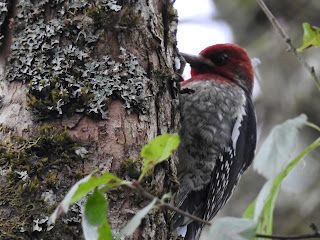Update: the wonderful folks on Oregon Birds Online offered great advice. First, Dave Irons let me know that my Carpodacus finches are now Haemorhous finches. He also said: "note that the bird has rather white and unstreaked undertail coverts. House Finches have dingier undertail coverts that are streaked in all plumages." That's another thing I didn't know (or find in my bird books.) Plus, Purple Finch "males of the western subspecies H. p. californicus can show a fair amount of streaking on the flanks." Ah ha!
Joel Geier, who has better eyes than I, said:
"The broad brownish cheek stripe showing through the reddish color on the head narrows this down to either a Purple Finch or a Cassin's Finch, and the curved culmen makes it a Purple Finch ..."
I can tell females apart by that head pattern, but sure couldn't see it on this bird. And the culmen looks straight in some of my photos and curved in others. Sigh.
Very helpful hints came from Judy Meredith, who has told me before (but I always seem to forget) that: "Often the case with ID is perplexing but I tend to use a collection of field marks and look for "most like" versus completely positive of ID." Here is her collection of field marks to separate Cassin's from Purple:
Undertail streaked in Cassin's, plain white in Purple.
Steaks on flanks crisp on Cassin's and blurred on Purple
Upper bill, culmen, is totally uncurved in Cassin's and has a slight curve in Purple. The Cassin's is as if you put two rulers together to form a triangle. No curve at all.
Back of bird in Cassin's usually has restricted coloring and Purple has wash which goes farther down along the back of the bird.
Chest in center and sides is white in Cassin's and in Purple it is a dingy white, not bright between steaks or central breast area.
Below are the photos lightened from the "photo fix" setting of my photo program. Thanks to all for the help! I now know this is a western subspecies (streaked flanks) of Purple Finch.
The wonderful folks on OBOL continue to add insights...
Wayne Hoffman provided the reason for the name change:
"...There are some pinkish Eurasian finches (rosefinches) that look sort of like our 3, and they were named Carpodacus. Subsequently, taxonomists noted the similarity of ours to those and put them in the same genus. Now, DNA analyses have shown that they are not close relatives, but instead the resemblance is convergence. The evidence says that the Asian rosefinches are more closely related to Bullfinches, Canaries, Goldfinches, and Siskins than they are to Cassin's, Purple, and House finches. Thus, they do not belong in the same genus, and because the Rosefinches got the name Carpodacus first, they get to keep it.. Now, according to the rules of priority (older names have priority over newer ones) the next oldest name that was ever used for any of the American 3 was Haemorhous, so that is what we get."
Pamela Johnstone explained bird colors from an artist's point of view...
" In my mind there are dyed and painted birds. The analogy has nothing to do with real birds. Male American Goldfinches are painted. Birds with a more transparent coloring like the Haemorus are dyed, because the brown shows through the red, which was applied with dye or watercolor after the brown was laid on."
Pam also noted that both House and Purple finches can come in many red/orange/yellow shades depending, on diet. "Both have color deficiencies when they don’t get enough carotenoids in their diet... Females don’t change, since it’s only the red that depends on carotenoids."
"Females are easier to i.d than males because the colors don’t vary and the
brown markings show their difference. The brown streak that people talk about on
a PUFI’s face shows up really well on them. I think of it as a thumbprint, which
means that it’s fairly broad, not like a line through the eye. It looks as if
someone set their thumb with the nail toward the bird’s bill and pressed a brown
ink mark over its eye. The body streaks are easier to see, too."
"PUFI have a bigger base to the bill, that extends higher up the forehead.
HOFI have a blunt little forehead above a dark beak, and PUFI have a continuous
slope down the profile from forehead to beak tip."
Thanks, all!


























































